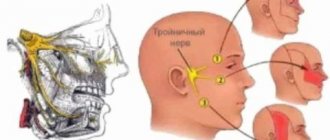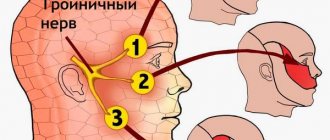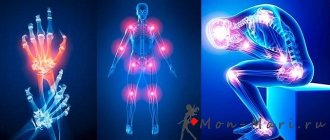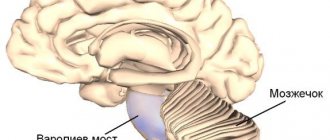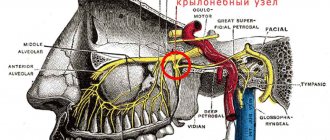Damage to the femoral nerve most often occurs in the area where it is located in the retroperitoneum, in the place where it connects with the inguinal bandage.
Diseases of the femoral nerve (neuritis, neuralgia and others) are characterized by weakness of the muscles in the area of innervation, their numbness and pronounced pain.
As a rule, most often this problem occurs in women due to their physiological characteristics after 40-50 years, since with age the thigh muscles wear out, which can lead to nerve damage.
Anatomical and physiological certificate
By its nature, the genital femoral nerve is formed from many fibers and nerves of the spinal cord.
Starting at the uppermost level, it is located near the psoas muscle and then passes under its outer edge. Most of the nerve endings are located in the small depression between the psoas muscle and the iliacus muscle. It is important to know: the small fascial leaves that are located in the area of the femoral nerve are divided into several plates in their structure: iliac, preiliac, transverse and peritoneal. Between all the plates there may be more than three small, so-called bursae, which contain a small amount of fatty tissue. This feature is due to the fact that the genital femoral nerve itself is located in a very tight fixation and because of this, small hematomas quite often form.
Coming out of the pelvic cavity, the nerve leaves this environment and passes through the osteo-fibrous tunnel, which is formed in the groin area.
Under the ligament, the nerve passes through the muscle lacuna. Upon exiting this area, the nerve falls under another sheet, which covers several iliac regions; in this place it is located in the area of the femoral triangle, in the inguinal bandage and the sartorius outside, and inside the long adductor muscle.
According to specialized medical literature, on the side of the femoral nerve there is a triangle of the same name, which with a deep sheet fixes the hips and smoothly passes into the iliacus fascia.
Well, then the femoral artery departs from the nerve itself; it is in this place that the nerve can be compressed by the resulting hematoma during a blow or bruise. A little higher from the inguinal band itself and the nerve, the iliac nerve branches and the psoas minor muscles extend.
These muscles go around the hip joint and form a kind of safety buffer.
The femoral nerve is quite vulnerable and susceptible to many diseases - neuralgia, neuritis, neuropathy and others.
Topographic anatomy of the femoral nerve:
Signs of damage to various departments
The topography of the nerve column and its branches makes it possible to compare the mechanisms of its injury and the symptoms of ailments.
Pinching between the lumbar muscle masses
Due to pathology, all underlying areas of the femoral nerve may be affected. The signal from the central nervous system does not reach either the muscular or sensory processes. As a result, muscles weaken and atrophy, and the skin becomes insensitive.
The affected limb decreases in volume, the knee reflex disappears. It is difficult for the victim to bend the hip and lift the limb in a supine position. At the same time, she freezes with her ankle extended as much as possible. When a person walks, he throws his leg forward absolutely straight and steps on the entire surface of the foot. The sensitivity of the skin under the inguinal fold, on the inside of the thigh and calf, and along the edge of the foot decreases.
With general numbness, a person suffers from burning painful sensations, as neuralgia develops.
Neuropathy is a dangerous pinched nerve
Femoral nerve neuropathy occurs at the lumbar level and can often be caused by pinching due to muscle spasm or hemorrhage, which can be caused by internal hemorrhage, overuse and injury.
Causes and symptoms
In addition, neuropathy can be caused by the following abnormalities:
- retroperitoneal hematomas;
- tumors;
- hemophilia;
- thrombocytopathy.
- muscle injury during intense sports exercises (stretching, etc.);
- formation of hematomas after injuries;
- intoxication of the body.
Any disease of the femoral nerve can act as a complication of another abnormality in the body. For example, neuropathy can develop as a complication of postoperative intervention.
Also, diseases in the area of the femoral nerve quite often occur in professional athletes. This can be caused by muscle strain, which leads to a pinched nerve. Instability of the knee joint can find its echo in this problem.
Diagnosis and treatment
Nerve damage, as a rule, is hidden (that is, the problem does not appear outwardly), but when complications occur, patients experience pain and pink-violet swelling in the affected area.
Neuropathy is an inflammatory process of nerve endings, which is characterized by damage to the myelin sheath, which subsequently leads to disruption of the conduction of nerve impulses. The disease is diagnosed during an initial examination.
Treatment takes place in stages and consists of:
- taking non-hormonal anti-inflammatory drugs;
- taking vitamins;
- therapeutic exercises and massage.
Diagnosis and treatment
Before prescribing a course of treatment, the patient must undergo a full examination, since the disease can be mistaken for a bruise or other pathological condition. Diagnosis is carried out using the following methods:
- electroneuromyography;
- MRI and ultrasound;
- computed tomography and x-ray.
If the preliminary diagnosis is obvious to the doctor, doctors limit themselves to ordering an X-ray examination of the patient, but if there are certain doubts, they most often prescribe an MRI.
Neuritis is a hidden danger to the femoral nerve
Neuritis is an inflammatory process that forms in the peripheral nerve. Symptoms appear throughout the nerve, with changes in the sensitivity of the affected area and muscle weakness.
Causes and symptoms
Femoral neuritis is a pathological injury to the nerves of the hip joint that can be caused by a number of different causes.
For example, such a condition can be caused by pinched fibers or the formation of a hematoma due to injury. Also, neuritis can manifest itself as a postoperative syndrome. The disease is characterized by pain and discomfort in the hip and knee area.
If 2 or more nerves were affected, the resulting disease is called polyneuritis.
Symptoms (except for the above):
- inflammatory processes;
- pinched fiber due to injury or hernia;
- impairment of limb activity;
- edema and swelling of a pink-violet color in the area of fiber damage.
The disease often manifests itself when trying to suddenly stand up, sit down, jump... Gradually, temporary pain develops into chronic pain.
Diagnosis and treatment
Diagnosis of the disease is carried out using various functional tests that determine the location and extent of damage.
Treatment in such a situation is carried out using fairly standard methods (taking painkillers and anti-inflammatory drugs, massage, exercise therapy and therapeutic exercises).
Also, after applying diagnostic measures, the neurologist develops a comprehensive treatment therapy, which will be aimed not only at masking discomfort, but also at removing the causes of this condition:
- taking anti-inflammatory and painkillers;
- therapeutic exercises, massage and physiotherapeutic procedures;
- electrotherapy by passing a small current through the body (this type of treatment is called impulsive current);
- Among the non-traditional methods of treatment, reflexology should be highlighted.
Causes of pathology
Inflammatory pathologies affecting peripheral nerves are united in medicine under the concept of neuritis. This condition is characterized by structural changes in the nervous tissue, which can provoke movement disorders and atrophy of specific areas.
Lumbago and sciatica - what is it and how to treat it?
Important! With late diagnosis and untimely treatment, this pathology can lead to paralysis.
Most often, neuritis develops for the following reasons:
- Injuries in the hip joint area (bruises, fractures).
- Inflammatory processes in the pelvis.
- Compression of the nerve trunk of the thigh.
- Hypothermia.
- Infectious diseases.
- Vascular pathologies.
- Diabetes.
Damage and subsequent inflammation sometimes occur against the background of unsuccessful surgery.
Prostrated and irritated by neuralgia
Neuralgia is a pathological disease of the peripheral femoral nerve, which is characterized by sharp and burning pain.
If in most cases, dysfunction of the fiber involves its damage, then in the case of neuralgia this condition causes irritation of the nerve endings in one area or another.
Causes and clinic
Neuralgia of the femoral nerve is a related disease with intervertebral hernia, which can be caused by the fact that the hernia, gradually growing, puts pressure on the nerve endings, which causes pinching of the fiber.
Pathology can manifest itself with various symptoms:
- discomfort and discomfort in the thigh area;
- increased pain syndrome;
- burning;
- change in body temperature.
In general, with regard to damage to the femoral nerve by one disease or another, it should be noted its gradual development and frequent pain not only in the hip area, but also in the groin area.
Diagnostics and therapy
The diagnosis of the disease is carried out by a neurologist, who conducts an initial examination of the patient and, depending on his state of health, prescribes a range of additional diagnostic measures. For example, magnetic resonance imaging of the entire spinal region is necessary to determine whether pinched nerve endings have occurred.
Using computed tomography of the retroperitoneal region, the clinical picture and severity of the disease can be accurately assessed.
As for treatment, in this case the main task is not only to hide the discomfort, but also to remove the cause of irritation of the nerve endings. For this purpose, a specially developed two-level treatment regimen is used, the essence of which is that taking Neurodiclovit not only relieves inflammation, but also has an analgesic effect.
Also needed:
- taking vitamin-containing medications;
- taking medications to improve blood circulation in the body;
- complex of exercise therapy procedures.
Symptoms
Typically, neuropathy of the external cutaneous nerve of the thigh has a gradual onset. The disease manifests itself with numbness of some areas of the skin on the lateral side of the thigh. Then the numbness spreads to the entire lateral and partly the front surface of the thigh. It is described by patients as a feeling of “dead skin” or “tissue covering the thigh.” Paresthesia is added - local sensations of cold, burning, pressure, goosebumps, trembling, tingling. Initially, these symptoms are periodic in nature, provoked by friction of clothing, walking or standing. In the future they are constantly present. Along with paresthesia, a pain syndrome occurs, the intensity of which decreases when the patient lies with his legs bent. The pain makes walking difficult. The gait becomes similar to intermittent claudication.
Consequences and preventive measures
Only at first glance it may seem that there is nothing terrible about damage to the femoral nerve, since other than discomfort, such a problem does not initially threaten anything.
But everything is not as rosy as many people think. In fact, only at first, disruption of the functioning of the fiber is an almost harmless disease. Over time, the pain and degree of damage increase, which can subsequently lead to a complete loss of sensitivity in the affected area. That is, numbness of the limb.
To prevent such diseases, it is necessary to resort to the following preventive measures:
- you need to adhere to proper nutrition, which will be rich in foods containing protein, but at the same time, the diet must be balanced;
- if you are an athlete, then before playing sports you need to do some basic stretching, which will prevent pinching of the nerve;
- The best prevention is timely consultation with a doctor.
How to treat the disease?
With neuritis of the femoral joint, symptoms and treatment are determined both by the localization of the pathological process and the characteristics of the causative factor. In severe cases, when compression is caused by the development of tumors or other neoplasms, surgical intervention is used. Surgeries are also indicated for severe sprains or tears of muscle fibers.
In case of pinching of the femoral nerve of a less pronounced nature, drug therapy is used, which eliminates pain and restores fiber conductivity. This treatment is complemented by methods of physiotherapy and exercise therapy.
Drug therapy
The treatment regimen for femoral nerve neuritis is selected based on the cause of the development of this pathology. If the compression is localized in the knee joint or groin area, local anesthetics such as Lidocaine or Novocaine are used. Drugs in this group relieve pain. Together with anesthetics, they resort to blocking the femoral nerve with glucocorticosteroids (Diprospan, Hydrocortisone). These medications suppress the inflammatory process.
In case of muscle paresis, drug treatment of neuropathy of the outer thigh is carried out using Neostigmine or Ipidacrine. Drugs in this group are prescribed for oral administration. Medicines improve the conduction of nerve signals to affected muscles.
In other cases, the following are used as part of drug therapy:
- Non-steroidal anti-inflammatory drugs (Nimesulide, Meloxicam, Voltaren). Suppress the inflammatory process and eliminate tissue swelling.
- Vasoactive drugs (“Aminophylline”, “Pentoxifylline”). Restore the functions of damaged nerve fibers, improve metabolic processes in the problem area. Together with vasoactive agents, vitamins B1 and B6 and thioctic acid are prescribed.
- Muscle relaxants (“Mydocalm”). Eliminate muscle spasm, thereby relieving pain.
- Anticonvulsants (Gabapentin, Topiramate). Suppresses cramps and relaxes muscles.
- Antidepressants (Fluoxetine, Amitriptyline). Used for chronic pain caused by neurogenic lesions.
The type of drug and dosage of the drug should be selected by the attending physician. A number of these medications cause serious complications.
Physiotherapy
When the thigh nerve is pinched, exercise therapy is used in combination with drug therapy. Exercises to restore the functions of the lower extremities should be performed only after the symptoms have been relieved and the causes of the disease have been eliminated.
Treatment of femoral neuralgia with various exercise therapy techniques depends on the symptoms of the disease. The type of exercise, the degree of physical activity and the order of performing tasks are also determined by the attending physician, based on the characteristics of a particular case. With the help of gymnastics you can achieve the following results:
- accelerate the restoration of damaged tissues;
- restore the functions of damaged nerve fibers;
- increase blood microcirculation in the problem area, thereby reducing the intensity of the inflammatory process;
- prevent the occurrence of joint stiffness, scars and adhesions;
- strengthen muscles and ligaments.
Regular exercise therapy contributes to the rapid restoration of the patient’s ability to work. If intense pain occurs during exercise, you must stop exercising.
Traditional medicine
The attending physician must determine what to do if a nerve is pinched in the thigh. This also applies to cases where therapy is carried out with traditional medicine.
Rules for treating neuralgia at home
It is necessary to treat the disease in question under the supervision of specialists - they will conduct a full examination of the patient and make competent prescriptions, especially since medications are selected on an individual basis.
Drug therapy
Neuralgia of any kind must be treated with the use of specific medications. Of course, the doctor must select specific medications and dosages, but there is also a general list of effective medications prescribed when diagnosing the disease in question. These include:
- muscle relaxants – sirdalud, mydocalm, baclofen; drugs with anticonvulsant effects - gabantine, finlepsin, tebantine, carbamazepim; topical ointments and gels – fastum-gel, deep relief, apizartron; vitamins from the B line - milgamma, neurorubin, cocarnit.
What does the femoral trunk innervate?
First of all, its work is aimed at innervating the muscles at the front of the thigh: the sartorius, adductor longus and quadriceps.
The saphenous nerve helps innervate the masses of the upper legs and is responsible for the sensation of external influences by the epidermis. The internal musculocutaneous branch oversees the corresponding femoral section. The lateral cutaneous nerve and its branches connect the surface of the thigh in the outer region with the central nervous system. The cutaneous and median branches are responsible for the part in front.

